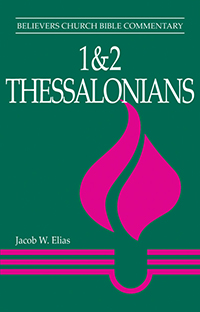Eschatology (in 1 & 2 Thessalonians)
![]() Home A B C D E F G H I J K L M N O P Q R S T U V W X Y Z Abbreviations Glossary
Home A B C D E F G H I J K L M N O P Q R S T U V W X Y Z Abbreviations Glossary
The word eschatology itself does not occur in the NT. It derives from a combination of two Greek words: eschaton, meaning "the last thing," and logos, meaning "word" or "teaching." Eschatology has therefore become a technical theological term for the doctrine concerning final events. Related themes include the parousia or coming of Christ, the resurrection of the dead, the judgment, and final rewards and punishment.
However, biblical eschatology deals with more than the future or the end of history or an otherworldly realm beyond this life. Jesus’ preaching and teaching centers on the imminence of the “kingdom of God” (Mark 1:15). This “kingdom,” though present (Luke 17:20–21), still remains future: “Your kingdom come” (Matt 6:10; Luke 11:2).
Much of Paul’s teaching reflects this eschatological tension between the “already” and the “not yet” of the arrival of God’s kingdom. According to Paul, believers find themselves living within the dynamic interplay of the present and the future. A key text in this regard is 1 Thess. 2:12, where Paul and his partners urge their readers to let the future (God’s "kingdom and glory") shape how they live in the present (“Kingdom of God” in TBC for 1 Thess. 2:1–12).
Biblical texts such as 1 and 2 Thessalonians are often interpreted in support of dispensational theology. The details vary, but generally a dispensationalist view of the end-times envisions a sequence of the following events:
- The rapture of the church, both the living and the dead in Christ, brings the present age to a close.
- Continuing residents of the earth experience the great tribulation, a seven-year period when Satan and his emissary the antichrist oppress Israel and the nations.
- However, some premillennialists put the rapture after the great tribulation. In this view, the church lives through the tribulation.
- The church returns to earth with Christ, thereby setting the stage for the conversion of Israel and a thousand-year reign of Christ from Jerusalem (the millennium; cf. Rev. 20:1–4).
- At the end of the millennium, Satan and his followers join in a final revolt against God, and the forces of evil are decisively defeated.
- Then comes the final judgment, followed by eternal life for believers and eternal punishment for nonbelievers.
Dispensationalism constitutes one expression of the theological and social phenomenon called millennialism. Its followers typically try to correlate current historical events with a presumed timetable for the end of history and the return of Christ. In addition to the premillennial scenario outlined above (Christ’s return before the millennium), there are various postmillennial constructs of the future (Christ’s return after the millennium). Essentially, postmillennialists expect the church to remain on earth during the millennium, when the reign of Christ will increasingly lead to peace and justice. At the end of this time, Christ will return in glory.
Given the various subtle interpretive moves required to sustain both the pre- and postmillennial positions, many Christians have chosen to position themselves with amillennialism (no literal millennium). In this understanding of biblical eschatology, the reign of Christ began with his initial coming, and the millennium symbolizes that whole present interim period during which believers who realize both the “already” and the “not yet” character of Christ’s reign await its final consummation.
Proponents of premillennialism (likely the dominant view among evangelicals in North America) also acknowledge that 1 and 2 Thessalonians do not expressly portray this particular chronological sequence of end-time events. For example, D. Edmond Hiebert, who holds the premillennial view, says:
- The view one accepts will be determined largely by doctrinal and exegetical presuppositions. (Hiebert, 1 and 2 Thessalonians [Chicago: Moody, 1992]: 218).
With reference to the timing of the rapture, Hiebert pleads for an attitude of sincere openness toward contrary views:
- Equally devout and sincere students of Scripture will doubtless continue to hold different views on the question of the time of the rapture. Advocates of their respective views must avoid attributing unworthy motives or insincerity in exegesis to each other because they do not agree. (219)
Hiebert also makes a further plea regarding efforts to establish a chronology of end-time events:
- It is appropriate and proper that diligent efforts should be given to the study of the evidence for a chronology of end-time events. But these efforts must not be allowed to lead to a preoccupation with uncertain details so that the sanctifying power of this blessed hope for daily living is lost sight of. (219)
Hiebert’s concluding admonition harmonizes with the pastoral character of Paul’s eschatological teaching in 1 and 2 Thessalonians. Holy living and faithful engagement in the mission of the church need to take priority. Efforts at deciphering chronological clues in Scripture can sidetrack the church from the mission which God desires to accomplish in the world.
Recommended for further study: David Ewert, And Then Comes the End (Scottdale, PA: Herald, 1980).
| —Jacob W. Elias |
